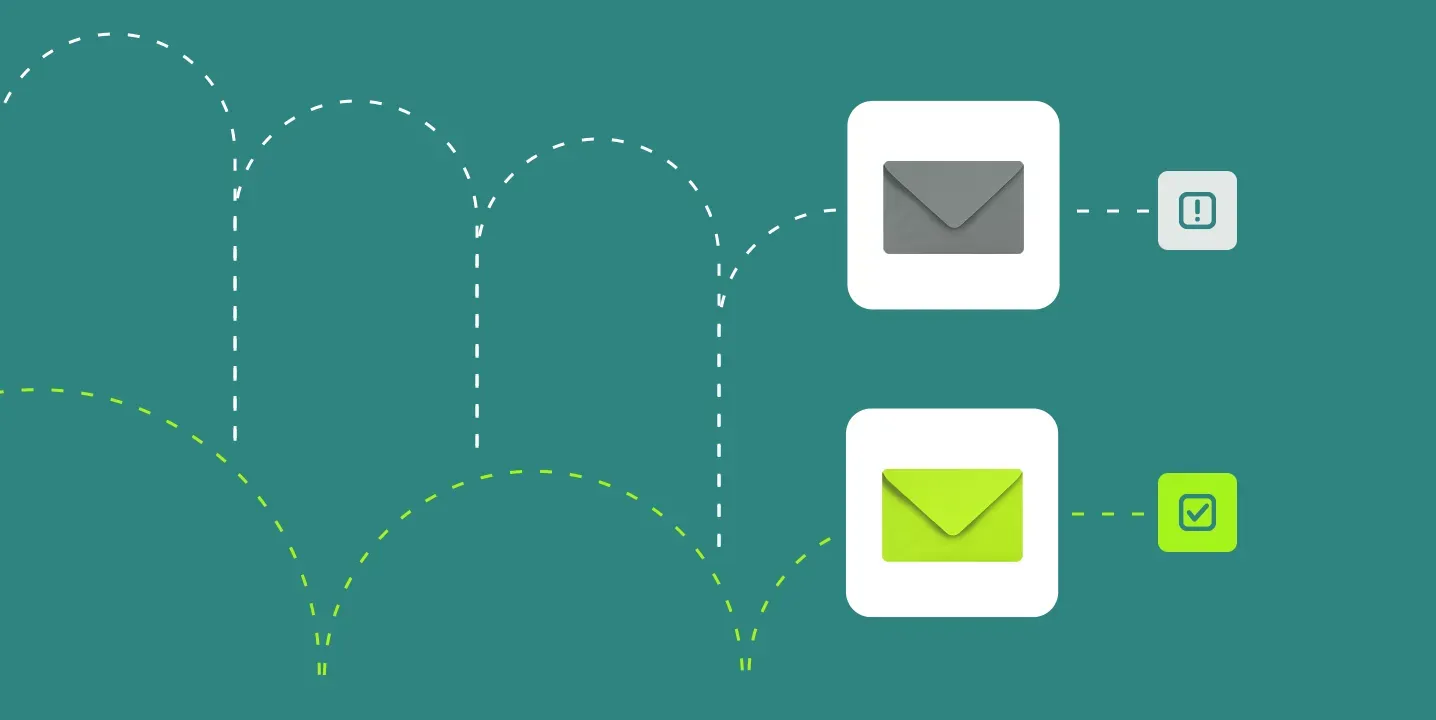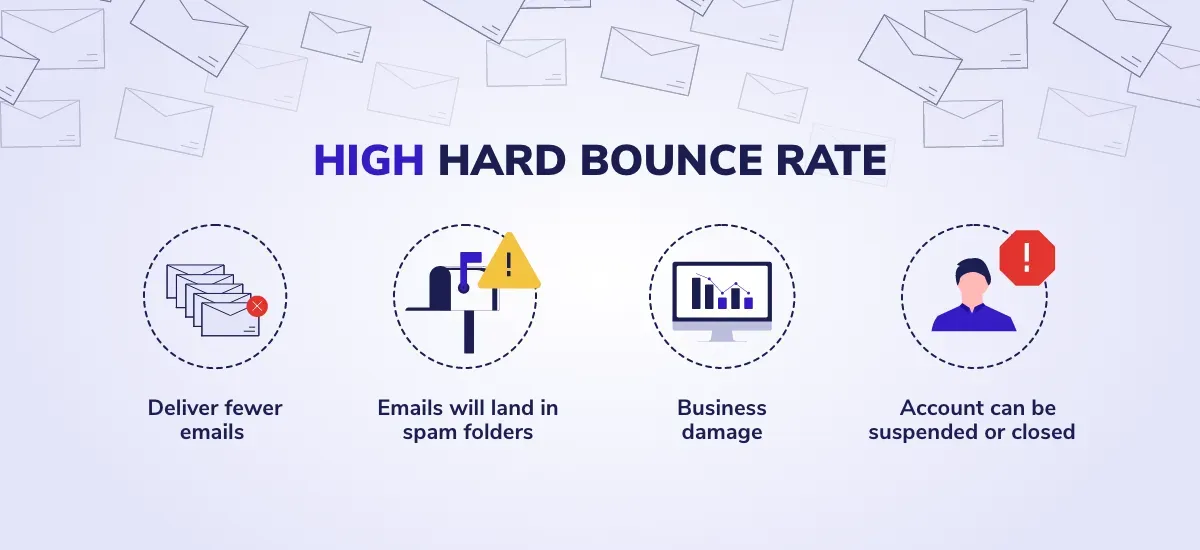What is a Hard Bounce?
A hard bounce is an email message that gets returned to the sender and cannot be delivered to the recipient. Unlike a soft bounce, which could be a temporary issue, a hard bounce represents a permanent reason why the email couldn't be delivered.
Root Causes of Hard Bounce
The main reasons for a hard bounce include invalid email addresses, a non-existent email server, or the recipient's email server has blocked your email. Hard bounces are serious issues in email marketing, as they can harm the sender's deliverability and reputation.
Difference Between Hard Bounce and Soft Bounce
Hard and soft bounces are both types of email delivery failures. However, they differ significantly. A soft bounce is a temporary issue, such as a full mailbox, where the email may be delivered on a future attempt, unlike a hard bounce which is permanent.
Impact of Hard Bounce on Email Marketing
Understanding the effects of hard bounces on your email marketing is crucial. It can have severe implications for your email sends, delivery rates, and consequently, your brand's reputation.
Damage to Sender's Reputation
A high hard bounce rate can severely dent the reputation of an email sender. Internet Service Providers (ISPs) keep track of email bounce rates, and a high hard bounce rate could lead to the sender being flagged as spam.
Impact on Deliverability Rates
Email deliverability is vital in email marketing. A higher rate of hard bounces means more emails being undelivered, which directly affects the campaign's success rate and overall ROI.
Measures to Avoid Hard Bounces
To improve email deliverability, it's essential to maintain a clean email list, verify email addresses before sending, regularly update your list, and avoid purchasing email lists.
The Role of Email Verification in Preventing Hard Bounces
Next, let's discuss how email verification can significantly reduce the chances of hard bounces.
What is Email Verification?
Email verification can be a savior in the battle against hard bounces. It involves checking whether an email address is valid and can receive emails, helping prevent possible hard bounces.
Benefits of Email Verification
Email verification can increase the deliverability rate, improve sender reputation, enhance customer engagement, and ultimately improve the overall performance of email marketing campaigns.
Choosing an Email Verification Service
When choosing a service, consider factors like accuracy, speed, customer support, security, and whether it offers API integration.
What Happens After a Hard Bounce?
Now, let's understand what steps are typically taken after a hard bounce occurs.

Review and Analysis
Once an email faces a hard bounce, it's necessary to review and examine the situation, analyzing the bounce message for the exact error code and the reason behind the failure.
Removal of Email Addresses
Following a hard bounce, it's often advisable to remove the associated email addresses from your list. Continuing to send emails to these addresses can harm your sender's reputation.
Use of Email Marketing Tools
Email marketing tools often provide mechanisms to automatically suppress hard-bounced addresses, further helping maintain email sender's reputation.
Using Hard Bounce Rates as a Performance Metric
Hard bounce rates can be a valuable metric for gauging the performance and success of your email marketing campaigns.
Understanding Hard Bounce Rate
The hard bounce rate is the number of hard bounces divided by the total number of emails sent. It's a crucial metric that provides insight into list quality and overall reach.
Tracking and Monitoring Hard Bounce Rate
High hard bounce rates indicate poor list hygiene or possibly even a spam trap. By tracking and monitoring your hard bounce rates, you can make necessary adjustments to your strategy to improve future campaigns.
Hard Bounce Rate Benchmarks
Industry benchmarks for hard bounce rates vary but generally, a rate lower than 2% is considered acceptable. Consistently high rates need immediate attention.
How to Recover from High Hard Bounce Rates
Finally, let's explore the steps you can take to bounce back from high hard bounce rates.

List Cleaning and Segmentation
Start by cleaning your list of any hard-bounced emails. Adopt email segmentation to target individuals with personalized marketing messages, encouraging engagement and reducing bounce rates.
Double Opt-In Feature
Implementing the double opt-in feature requires subscribers to confirm their email address before being added to your list, thus reducing the chances of invalid addresses.
Regular Auditing of Email Practices
By regularly reviewing and auditing your email practices, you can identify problem areas and opportunities for improvement. It's necessary to keep up with the ever-changing practices of email marketing to improve results.
Frequently Asked Questions (FAQs)
What triggers a hard bounce in email marketing?
A hard bounce in email marketing is triggered when an email is permanently rejected due to reasons like an invalid email address or domain, or the recipient's server blocking delivery altogether.
How does a hard bounce differ from a soft bounce?
A hard bounce indicates a permanent delivery issue, like an invalid address, while a soft bounce is a temporary issue, such as a full inbox or a server being down.
What impact do hard bounces have on email campaigns?
Hard bounces can negatively impact email campaigns by lowering delivery rates, harming the sender's reputation, and potentially leading to blacklisting by ISPs if not managed properly.
How can you prevent hard bounces?
Prevent hard bounces by regularly cleaning your email list, using double opt-in processes, and avoiding purchasing email lists to ensure all addresses are valid and actively engaged.
What should you do if you experience a hard bounce?
If you experience a hard bounce, immediately remove the bounced email addresses from your list to maintain your sender reputation and improve your overall email deliverability.

